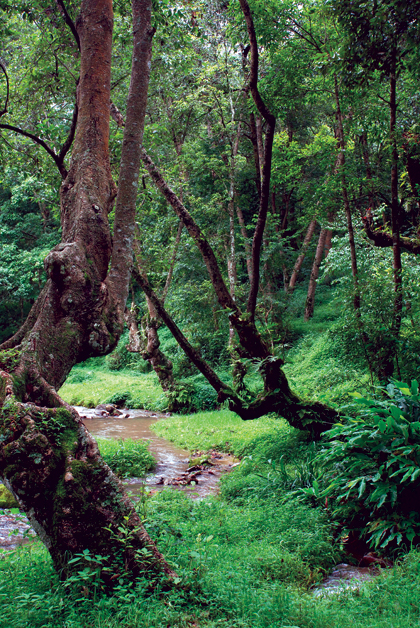Can Nepal become a developed country? Will the Nepalese ever achieve the standard of living enjoyed by people of the first world? Children begging for alms on the streets, decrepit vehicles hurtling down the potholed city roads and the primitive lifestyle in villages, towns and cities outside of Kathmandu Valley are grim reminders that Nepal is a poor, third world, slowly developing country. Looking at the state of affairs, therefore, the idea of high living standard appears a far-fetched one. But once you go a little deeper and dig out more information about the country and widen your scope of inquiry, and see the wealth of natural resources that exists here, you’ll see that the goal of an improved standard of living is eminently achievable.
 Rich in hospitality, culture, scenery, bio-diversity and natural resources, the country is not just admired by tourists out to have fun, but also by scholars, scientists and researchers from around the world seeking to enhance knowledge in the fields of anthropology, linguistics, botany, zoology and other sciences. Then there are others who have gone a step further to invest in hospitality sectors and some who have shown keen interest in exploring the potentials of agriculture, horticulture, floriculture, ayurvedic medicines and host of other enterprises that tap the nation’s natural wealth. They are the people whose perception about Nepal have taken an about turn over the time.
Rich in hospitality, culture, scenery, bio-diversity and natural resources, the country is not just admired by tourists out to have fun, but also by scholars, scientists and researchers from around the world seeking to enhance knowledge in the fields of anthropology, linguistics, botany, zoology and other sciences. Then there are others who have gone a step further to invest in hospitality sectors and some who have shown keen interest in exploring the potentials of agriculture, horticulture, floriculture, ayurvedic medicines and host of other enterprises that tap the nation’s natural wealth. They are the people whose perception about Nepal have taken an about turn over the time.
Their enlightenment?—that Nepal is richer than many developed countries in terms of per capita allocation of natural resources!
Yarsagumba, the mysterious herb
People of Humla, Jumla and Dolpa, for example, can earn between 60,000 to 1 lakh rupees or more per day collecting just one kilogram of a strange type of medicinal ‘herb’ called yarsagumba. Children bunk school, adults leave aside their routine work and women spend great amounts of time collecting these herbs. Dolpa is known as the major source for this exotic elixir-like substance. Yarsagumba, also called yarchagumba (or jeevan buti, in Nepali), is found in sub alpine meadows from 3,500 meters (11,500 feet) and above. It is collected between May and July each year, and it is known that more than one harvester has lost his life while searching for this herbal fungus at high altitude. What’s amazing is the value of this mountain herb. A tentative estimate suggests that yarsagumba currently sells for at least 200 rupees per strand. Since there is no formally regulated market in the herb, at least not within Nepal’s frontiers, its prices witness a high degree of volatility—from 315 rupees a decade and half ago to 105,000 rupees (or more) per kilogram today.
And, just what is this popular, lucrative and mysterious herb? Yarsagumba is a rare species of parasitic caterpillar fungus known to scientists as Cordyceps sinensis. This medicinal elixir-like substance is claimed by many people to be a life saving herb popularly used as an aphrodisiac and tonic, one that improves overall immunity of the body.
If the rampant collection of yarsagumba goes on unchecked, however, people might end up disrupting the alpine ecology where it grows, potentially putting it on the endangered species list. The process of collecting yarsagumba, therefore, needs to be regulated in a way that allows controlled harvesting, but which does not deprive the villagers of a source of income.
Yarsagumba is just one of some 700 herbs with medicinal properties recorded in Nepal to date. Researchers say that a comprehensive study encompassing the length and breadth of the country can push the number of the plants species with medicinal value to more than a thousand.
Only 188 medicinal herbs are listed as commercially important by the Nepal government. In the local context, however, more than 200 herbs are being used in homemade ayurvedic medicines by dhamis (shamans), baidyas (healers) and kaviraj (pharmacists) to cure diseases and illness affecting people living Nepal. And there are concerns that many other high value medicinal herbs are being collected and shipped illegally or sold at much cheaper rates to neighboring countries. Nepal’s medicinal plant business is big business and could be even bigger, under the right circumstances.
According to some observers, the Nepal government and its agencies have failed, however, to create an environment for fruitful interaction between traditional healers and certified medical practitioners. Done right, the outputs from this business could not only stop the unscrupulous squandering of precious herbal resources, but also ease budgetary constraints on investing in research. It could also improve the livelihoods of the healers and provide affordable medical alternatives to rural folks and others who neither have access to good health services, nor the means to pay for costly medicines.
In order to save these valuable resources from extinction and illegal exploitation government has, in the past, outlined several measures and pursued several strategies. Where implemented in a consistent manner, they work well; where not, they have failed to come up to their promise. Meanwhile, medicinal herbs are an important part of our natural wealth that need immediate attention to keep Nepal‘s future flourishing.
Declining and rejuvenating forests
Past and present research has shown that Nepal’s vast forest cover spread across various zones has been receding at an alarming rate. A government report of the past shows that the country’s forest cover declined from 43% in 1978 to 37.4% in 1986 and subsequently to 29% in 1998. A recent estimate by UN Food and Agriculture Organization (FAO) puts the figure at 25.4%, hinting at continuous deterioration. Reports also suggest that the degeneration of forests at different stages were directly linked to the growing population. Vast tracts of forest were cleared for human settlement throughout 1950s, 60s and 70s. Other studies, however, show that while absolute forest cover has gone down, the number of trees on the ground may have gone up in many districts, especially where there are active reforestation and farm forestry projects. A few years ago in Sindhupalchok and Kavre, for example, Nepal-Australia project foresters reported a tremendous increase in the number of trees being grown outside of the forests, on farms, compared with a quarter of a century earlier.
Considering the issues of deforestation and paying heed to a World Bank warning of 1978 that the forests of Nepal would be wiped out and turn to semi-desert in 15 years if the decline in forest cover continued at the same rate, and another study that said “the Himalaya will become as bald as a coot overnight” soon, steps were taken starting in the late 1970s to avert impending disaster. In 1978, the government, with assistance from the FAO, began its innovative community forestry program. At first, some forest lands were declared national property and local people dependent on them were not allowed to enter—the people were, in fact, labeled as a major threat to the health of the forests.
Ultimately, however, foresters and other government officials began to realize that, as one wise international forester once put it, “Forestry is not about trees. It is about people, and it is about the trees only when trees can serve the needs of the people.” Following that, the responsibility and rights to manage local forests were gradually handed over to local groups and Nepal’s innovative—and now globally recognized and praised—community forestry program was born. The 1980s was a decade of experimentation and adjustment to the program, so that by the early 1990s, through the Forest Act of 1992 and Forest Rules of 1994, community forest user groups were firmly established as indispensable rights holders. Local user groups were given primary responsibility for the planning, development, conservation, utilization and management of local forests.
Today there are well over 14,000 community-based forest user groups nationwide, directly benefiting almost 40% of the total population of Nepal. These forest user groups involve the membership of over 1.6 million households, most of which fall in the low
income category. The forest user groups are taking care of and managing 1,187,723 hectares of forests that apart from serving their daily needs for fuel and cattle fodder also act as a source of income generation.
Forest wealth
Income generation from community and national forests is big business across Nepal. Take the indigenous production of Nepali paper products, for example. The bark of lokta and argeli (of the species Daphne and Edgeworthia, respectively) have, over the past few decades, fueled important forest resource based businesses in Nepal.
Argeli is a moderately high altitude plant that grows naturally in the mid-hills region of Nepal at 1800 and 2600 meters (approximately 6,000 to 8,500 ft). The fibrous argeli bark is exported in large quantities from Nepal to Japan for use in making the highly durable Yen currency notes. The argeli, called mitsumata in Japanese, is harvested in Nepal in 13 mid and high hill districts, from Myagdi northwest of Pokhara to Illam in the far east. The next time you visit Japan, when you hold out that multi-yen note to pay for your sushi and tea, remember Nepal!
The more well known source of Nepali paper is lokta (or daphne) bark. It grows in the understory of the high forests, from 6500 ft and up (that is, above 2000 m). The historically most famous production of lokta-based Nepali paper is from Baglung and neighboring districts west of Pokhara, and from several districts north and northeast of Kathmandu. It’s a good business. For example, indigenous paper processing and production units set up under the Bhatekhola and Kmala Bhai Community Forests of Dolakha District have recently earned those communities almost 800,000 rupees over a span of five years.
Some village people are engaged in harvesting the raw bark fibers, others make the paper to strict specifications in rural villages, and still others market it to factories where it is converted into a variety of end products, mostly in the form of colorful handicrafts. Lokta paper, also called Nepali kagaz, is noted for resistance to insects and mildew and for long lasting qualities, as the natural fibers prevent easy tearing. The paper readily absorbs dyes, which allow it to take up an array of vibrant colors and unique textures. In the past it was a single purpose product used primarily by the Nepal government for record keeping. You can still see it in old government office ledgers. These days, however, lokta paper is in high demand from paper-craft industries and businesses for making notebooks, bags, gift boxes, greeting cards, photo-frames, designer lampshades, art paper and wrapping sheets. A walk through the tourist shops of Thamel and the various cooperative craft outlets in Kupandole will show you the amazing range of lokta paper products available on the market. What’s for sale here is only a fraction of what is exported to buyers around the world.
The handmade paper business was not, however, always as brisk as it is today. During 1930s it’s virtual monopoly was constrained by competitive imports from Tibet and, by the 1960s, machine made papers from India nearly wiped out the traditional Nepalese paper making industry altogether. By the end of the 1970s only a few families in Baglung District and in neighboring Parbat retained technical knowledge of the once familiar traditional paper making process.
The handmade paper industry, facing slow and certain death, was brought back to life by growth in tourism combined with the insightful help of UNICEF, through its progressive ‘Community Development Through the Production of Handmade Paper Project‘ launched in 1980. Through the project, the knowledge of paper making was rediscovered and rejuvenated in the rural villages, the harvesting of lokta was given scientific support, and a flourishing paper products finishing industry was established in Bhaktapur. Since then, many NGOs and private companies have sprung up to capitalize on the lokta paper products business.
Today, there are 170 active handmade paper making units out of 300 registered with the Small and Cottage Industries Department. Their exports in 2001/02 were worth about US$3.5 million and, since late 1990s, all handmade paper product exports have increased by an average of 26 percent. Major markets for Nepali paper products are the USA, UK, France, Japan and India. The handmade paper industry provides employment for 4,155 families, or about 21,000 persons, with women making up 80 percent of the work force, according to a recent study. These facts and figures show that forest-based resources can be a major source of employment generation, even for those who are illiterate and do not stand a chance to be employed anywhere else.
Community sawmills
Other communities have generated huge incomes by selling timber and other forest products from their community forests. With assistance from a joint Nepal-Australia community forestry project in Kavre and Sindhupalchok Districts, for example, the Chaubas Bhumlu Community Sawmill earned over 53 million rupees from the sale of 60,000 cubic feet of wood in 2005 alone, while the Smaller Ichha Devi Sawmill earned 1.8 million with the production of 18,300 cubic feet of timber. Similarly, with the help of a Nepal-Swiss project, community forest user groups in Dolakha, Ramechhap and Okhaldhunga Districts were able to sell 168,000 cubic feet of wood the same year. In these otherwise poor hill communities this is big business! These are just a few of the 14,258 community forests that are set up to provide a better means of subsistence and income generation for many poor rural Nepalis.
Community forests, however, are not without their problems. For example, while user group rules may allow sales to outsiders from community sawmill operations only after the needs of the community members are met, in some instances, in order to keep the user group treasury plush, only limited quantities of timber are available locally, and more is sold to outside contractors. In some instances elite men tend to capture the leadership positions in user groups, to the distinct disadvantage of women and of the poor and less powerful community members. And some user group officers are known to work in collusion with higher authorities to cut more trees than annually permissible or sustainably viable, and auction them off to favored contractors at minimal prices.
Bright prospects
Despite the inevitable problems noted above, and others that are well documented by Nepali and foreign researchers, Nepal’s community forestry program is recognized worldwide as a model system for engaging local people in managing and sharing the benefits from local resources. A recent Google search on ‘community forest’ came up with 229,000 hits, of which 48,200 were directly associated with Nepal. An international student of forestry came to pay a visit to the Institute of Forestry in Pokhara a few years ago. When asked why she had come so far, she replied “because everyone knows that Nepal is the world leader in community forestry.”
Timber, as well as medicinal herbs and handmade paper are all forest-based products with great potential for helping to alleviate poverty in Nepal. Nepal’s overall botanical wealth along consists of 10,091 known plant species (and more are yet to be discovered). These include 5,600 species of flowering plants, which by comparison is four times that of the UK. Botanists claim that once Nepal’s poorly known remote regions are fully explored the figure will exceed 7,000 species of flowering plants.
To gain and to further capitalize on the diverse botanical resources for the benefit of all, but especially the poor, more and better management of all these resources is required. And, for that, more and better research on production and sustainable management is necessary. At the same time, the various forms of corruption, negligence, plundering and greed known to exist across the natural resource sectors need to be addressed straight on and ‘rooted out’, so to speak.
Hariyo ban Nepal ko dhan (‘Green forests are Nepal‘s wealth’) is an age old adage in Nepal. It reminds us that the nation’s rich bio-diverse resources have tremendous potential for good. Properly managed, harvested and capitalized, they have the potential to put the per capita earnings of Nepalese people several notches higher even than people of many well-to-do nations. This can happen, provided that the good people-centered policies are in place (some are), that the resources are managed sustainably (some are) and that the benefits are equitably distributed. The natural resources are here, the forests are green, and the prospects for doing it right are very high.
Some facts and figures used in this article are taken, but not only, from Hamro Ban, a book published by Ministry of Forest and Soil Conservation, Nepal, and a research paper funded by Food and Agriculture Organization of the United Nations.
Gokarna Forest Resort The Royal Hunting Ground
As you drive along the winding roads that lead you to the gates to Gokarna Forest Resort, its hard to...









